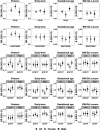Associations of Organophosphate Ester Flame Retardant Exposures during Pregnancy with Gestational Duration and Fetal Growth: The Environmental influences on Child Health Outcomes (ECHO) Program
- PMID: 38262621
- PMCID: PMC10805613
- DOI: 10.1289/EHP13182
Associations of Organophosphate Ester Flame Retardant Exposures during Pregnancy with Gestational Duration and Fetal Growth: The Environmental influences on Child Health Outcomes (ECHO) Program
Erratum in
-
Erratum: "Associations of Organophosphate Ester Flame Retardant Exposures during Pregnancy with Gestational Duration and Fetal Growth: The Environmental influences on Child Health Outcomes (ECHO) Program".Environ Health Perspect. 2024 Apr;132(4):49003. doi: 10.1289/EHP14968. Epub 2024 Apr 10. Environ Health Perspect. 2024. PMID: 38598327 Free PMC article. No abstract available.
Abstract
Background: Widespread exposure to organophosphate ester (OPE) flame retardants with potential reproductive toxicity raises concern regarding the impacts of gestational exposure on birth outcomes. Previous studies of prenatal OPE exposure and birth outcomes had limited sample sizes, with inconclusive results.
Objectives: We conducted a collaborative analysis of associations between gestational OPE exposures and adverse birth outcomes and tested whether associations were modified by sex.
Methods: We included 6,646 pregnant participants from 16 cohorts in the Environmental influences on Child Health Outcomes (ECHO) Program. Nine OPE biomarkers were quantified in maternal urine samples collected primarily during the second and third trimester and modeled as -transformed continuous, categorized (high/low/nondetect), or dichotomous (detect/nondetect) variables depending on detection frequency. We used covariate-adjusted linear, logistic, and multinomial regression with generalized estimating equations, accounting for cohort-level clustering, to estimate associations of OPE biomarkers with gestational length and birth weight outcomes. Secondarily, we assessed effect modification by sex.
Results: Three OPE biomarkers [diphenyl phosphate (DPHP), a composite of dibutyl phosphate and di-isobutyl phosphate (DBUP/DIBP), and bis(1,3-dichloro-2-propyl) phosphate] were detected in of participants. In adjusted models, DBUP/DIBP [odds ratio (OR) per ; 95% confidence interval (CI): 1.02, 1.12] and bis(butoxyethyl) phosphate (OR for high vs. ; 95% CI: 1.06, 1.46), but not other OPE biomarkers, were associated with higher odds of preterm birth. We observed effect modification by sex for associations of DPHP and high bis(2-chloroethyl) phosphate with completed gestational weeks and odds of preterm birth, with adverse associations among females. In addition, newborns of mothers with detectable bis(1-chloro-2-propyl) phosphate, bis(2-methylphenyl) phosphate, and dipropyl phosphate had higher birth weight-for-gestational-age -scores ( for detect vs. ); other chemicals showed null associations.
Discussion: In the largest study to date, we find gestational exposures to several OPEs are associated with earlier timing of birth, especially among female neonates, or with greater fetal growth. https://doi.org/10.1289/EHP13182.
Figures

References
-
- Yang Y, Chen P, Ma S, Lu S, Yu Y, An T. 2022. A critical review of human internal exposure and the health risks of organophosphate ester flame retardants and their metabolites. Crit Rev Environ Sci Technol 52(9):1528–1560, 10.1080/10643389.2020.1859307. - DOI
MeSH terms
Substances
Grants and funding
- U2C ES026542/ES/NIEHS NIH HHS/United States
- P01 ES022841/ES/NIEHS NIH HHS/United States
- UH3 OD023290/OD/NIH HHS/United States
- UG3 OD035540/OD/NIH HHS/United States
- UH3 OD023248/OD/NIH HHS/United States
- R01 ES027051/ES/NIEHS NIH HHS/United States
- UH3 OD023287/OD/NIH HHS/United States
- UH3 OD023305/OD/NIH HHS/United States
- P30 ES017885/ES/NIEHS NIH HHS/United States
- UH3 OD023288/OD/NIH HHS/United States
- R24 ES029490/ES/NIEHS NIH HHS/United States
- R01 NR014800/NR/NINR NIH HHS/United States
- U24 OD023382/OD/NIH HHS/United States
- UH3 OD023289/OD/NIH HHS/United States
- P30 ES007048/ES/NIEHS NIH HHS/United States
- P30 ES010126/ES/NIEHS NIH HHS/United States
- R01 HD083369/HD/NICHD NIH HHS/United States
- U2C OD023375/OD/NIH HHS/United States
- UH3 OD023275/OD/NIH HHS/United States
- UH3 OD023318/OD/NIH HHS/United States
- U24 ES028533/ES/NIEHS NIH HHS/United States
- UH3 OD023286/OD/NIH HHS/United States
- UH3 OD023271/OD/NIH HHS/United States
- P30 ES005022/ES/NIEHS NIH HHS/United States
- U24 OD023319/OD/NIH HHS/United States
- P30 ES023513/ES/NIEHS NIH HHS/United States
- UG3 OD023365/OD/NIH HHS/United States
- UH3 OD023272/OD/NIH HHS/United States
- UG3 OD023272/OD/NIH HHS/United States
- P50 ES026086/ES/NIEHS NIH HHS/United States
- UG3 OD023289/OD/NIH HHS/United States
- P30 ES030284/ES/NIEHS NIH HHS/United States
- UG3 OD023275/OD/NIH HHS/United States
- UH3 OD023342/OD/NIH HHS/United States
- UH3 OD023349/OD/NIH HHS/United States
- UH3 OD023365/OD/NIH HHS/United States
- P20 GM104416/GM/NIGMS NIH HHS/United States
- L60 MD001570/MD/NIMHD NIH HHS/United States
LinkOut - more resources
Full Text Sources
Miscellaneous

